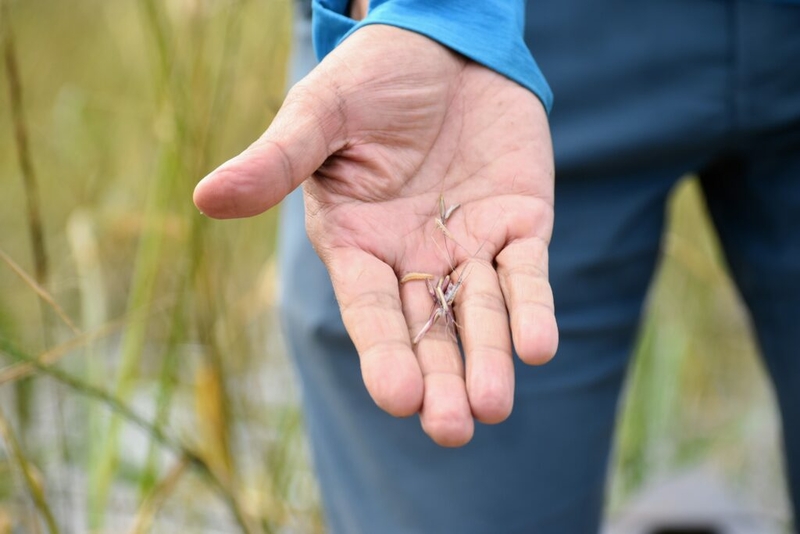Return to tradition: How a year of harvest culminates in an Indigenous ‘Turkey Day’ feast

“Everyone has their own way of doing it,” Sault Tribe citizen Nathan Wright says, balancing his weight while carefully bending down in the jiimaan (canoe).
He takes the wooden harvesting sticks and gives two hard knocks to the manoomin (wild rice) strands between them, letting loose a flurry of spindly seeds around his feet.
Yards away across the water and through a veil of manoomin reeds, Shylee Worthington steadies the stalks with a stick in one hand and uses the other to brush the manoomin off and into the jiimaan.
By the time both jiimaanan are pushed out of the manoomin beds and paddled back to the grassy shore of the small northern Michigan lake, both have enough to fill up a small tarp.
Once fully prepared, the ancient grains will complement countless dishes — manoomin and berries topped with maple syrup, manoomin soup with venison, corn and potatoes, manoomin and squash — but there are many steps between.
That’s particularly if you wish to transmute the plant into food via the traditional Anishinaabe way, as Little Traverse Bay Bands of Odawa Indians (LTBB) citizen Dan Hinmon sets out to do when he harvests and restores manoomin beds across Michigan.
From poling and knocking to parching, jigging and winnowing, the process is a sustainable labor of love and respect for the food that is an essential part of Anishinaabe culture, life, identity and livelihood.
Such are many Indigenous traditions that, long threatened with extinction after the arrival of white settlers, are being reclaimed in Native communities all across North America. And while the complex roots of the Thanksgiving holiday trace back to a time of genocide and land theft for Indigenous people, many now take the day as an opportunity to bring together family, traditionally harvested food and a sense of gratitude for cultures that have survived centuries of oppression.
This is called “Turkey Day.”
“As time went on, especially in the last 10 years, a lot of us started to feel differently about Thanksgiving Day because of all the things that happened,” Wright said. “We still wanted to maintain that tradition … but it’s just different for us. It’s becoming more of a powerful thing for us to reclaim, reconnect with our past.
“And we’re actually actively contributing in collecting food and harvesting food like our ancestors.”
In late September, off the grid in a woodland clearing closer to Little Traverse Bay, the sounds of wooden mallets striking strips of birch bark echoed through the traditional LTBB pow wow grounds. In a small building with doors wide open, a group of men put the finishing details on a contemporary Ojibwe birch bark canoe, or wiigwaasi-jiimaan; on the opposite wall, women threaded cattails into a ceiling-height mat.
Most jiimaan-related inquiries were directed back to Sault Tribe elder Ron Paquin, a revered artist with the uncommon specialty of building jiimaanan in the old Ojibwe way. At 80 years old, the birch bark structure he toiled over was to be his 79th jiimaan.
The men helping with the job listened carefully; the guidance Paquin doled out served as a precious account of an ancient tradition threatened by colonial governments and the passage of time.
“What fascinates me in the first place is the knowledge it took to build the first one they built,” Paquin told the Advance.
“I think it’s important to teach the Indian way … keep it traditional.”
It has been mere decades since the shuttering of the last Indian boarding school in the United States. Anishinaabek culture, traditions and language, pummeled for centuries with government-sponsored directives to drive them into extinction, have only recently been afforded the opportunity to blossom, be revitalized and circulate down generations.
And those traditions — like jiimaan building, mat making and manoomin harvesting — are only preserved in Indigenous communities because of elders like Paquin, and tribal members who help pass those traditions along.
The decolonization of food and the revitalization of traditional practices like 𝘫𝘪𝘪𝘮𝘢𝘢𝘯 building are living proof of Indigenous wisdom and resilience.
Other practices that are being revitalized are hunting and planting. Deer hunting is done sustainably and respectfully — a contrast to the often showy and trophy-oriented deer hunting culture in America.
Once a deer is shot, either with a bow and arrow or a gun, “what we do is we put their last meal in their mouth … that represents their last meal. And then we say a prayer for the deer,” Wright said.
“We’re thankful that this was gifted to us. And we give that animal a lot of respect.”
A prayer with tobacco is also said before pushing out to harvest manoomin.
“This whole thing of food sovereignty and decolonization — this is all, to me, is an accumulation of everything we’ve done that year with food, wild harvesting, what we’ve grown,” Wright said. “We could sit here during a Turkey Day season and celebrate all of those things that we did in one meal.”









































